Augmented Reality in eCommerce: Redefining How We Shop Online
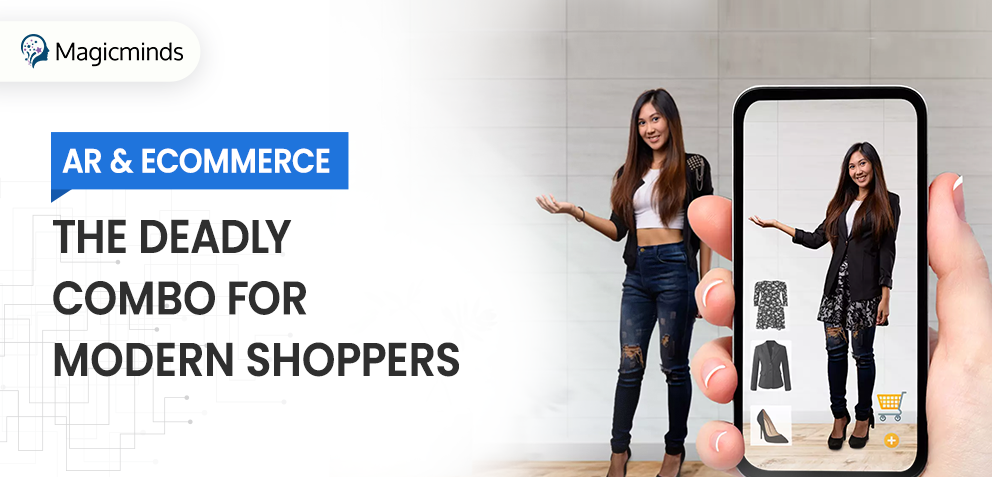
Tags
 Stay In-the-loop
Stay In-the-loop
Get fresh tech & marketing insights delivered right to your inbox.
Share this Article
Category
- .Net Developer
- Adtech
- Android App Development
- API
- App Store
- Artificial Intelligence
- Blockchain Development
- Chatbot Development
- CMS Development
- Cybersecurity
- Data Security
- Dedicated Developers
- Digital Marketing
- Ecommerce Development
- Edtech
- Fintech
- Flutter app development
- Full Stack Development
- Healthcare Tech
- Hybrid App Development
- iOS App Development
- IT Project Management
- JavaScript development
- Laravel Development
- Magento Development
- MEAN Stack Developer
- MERN Stack Developer
- Mobile App
- Mobile App Development
- Nodejs Development
- Progressive Web Application
- python development
- QA and testing
- Quality Engineering
- React Native
- SaaS
- SEO
- Shopify Development
- Software Development
- Software Outsourcing
- Staff Augmentation
- UI/UX Development
- Web analytics tools
- Wordpress Development
Augmented Reality (AR) in the realm of eCommerce stands out as a highly potent tool for enhancing both sales and the overall user experience in online shopping. Many, particularly eCommerce entrepreneurs and mobile app developers, view it as a game-changing solution that can tip the scales in favor of online shopping when compared to traditional brick-and-mortar stores.
Market Insights on Augmented Reality in eCommerce
Augmented Reality in eCommerce: Bridging the Gap Between Real & Virtual Shopping
Benefits of Augmented Reality in eCommerce
- Omnichannel AR Shopping Experiences
- Personalizing Online Shopping
- Improving Conversion Rates
- Reducing Return Rates
How Can eCommerce Mobile App Based Brands Leverage Augmented Reality
- Virtual Try-On Solutions
- Virtual Showroom
- Interactive User Guides
- Social Media Filters
Use Cases of Augmented Reality in eCommerce
- Sephora Virtual Artist
- Amorepacific Augmented Reality Mirror
- Lego/Snapchat/Kabooki
Market Insights on Augmented Reality in eCommerce
Take these insights into account—
- Companies offering unique AR encounters are 41% more likely to engage consumers compared to those lacking such experiences.
- Looking ahead to 2025, an impressive 76% of consumers foresee incorporating AR into their everyday routines as a practical tool.
As these stats provide an overview of what value AR holds in eCommerce mobile app development, let’s explore the manifold benefits of AR in eCommerce in this blog.
Augmented Reality in eCommerce: Bridging the Gap Between Real & Virtual Shopping
In simple terms, AR enhances real-world experiences by blending computer-generated imagery, such as text, images, and sounds, seamlessly into the user’s environment. It blurs the line between the virtual and the real, often delivered through smartphones or tablets, using their cameras to merge digital and physical realms.
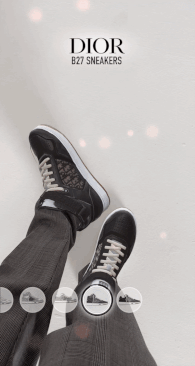
Source: Dior/Snap Inc.
This creates a live video feed on the device’s screen, offering contextually relevant information, from navigation cues to entertainment like Pokémon Go.
Unlike Virtual Reality (VR), which immerses users completely in a virtual world via headsets, AR keeps users connected to the real world while augmenting it with digital elements.
Benefits of Augmented Reality in eCommerce
Omnichannel AR Shopping Experiences
An effective omnichannel strategy revolves around prioritizing the customer’s needs and preferences. Omnichannel Augmented Reality (AR) presents an opportunity to position your company as truly customer-centric.
Imagine you are the proprietor of an electronics retail business. Given the growing trend of tech-savvy consumers making online purchases, would it not be prudent to offer undecided in-store shoppers an opportunity to further deliberate on their potential purchase? Indeed, it would.
What sets your store apart is the concept of providing these uncertain shoppers with an augmented reality marker or booklet to take home. When scanned, this marker or booklet unlocks a 3D model of the product under consideration, complete with all relevant information. Additionally, customers have the option to visualize how the product would fit into their own living spaces.
Personalizing Online Shopping
Augmented Reality (AR) opens up the potential to deliver a tailor-made online shopping journey for customers and top mobile app development companies are well aware of it. As an illustration, it enables individuals to virtually “try on” clothing items, providing a visual representation of how the garments appear on them.
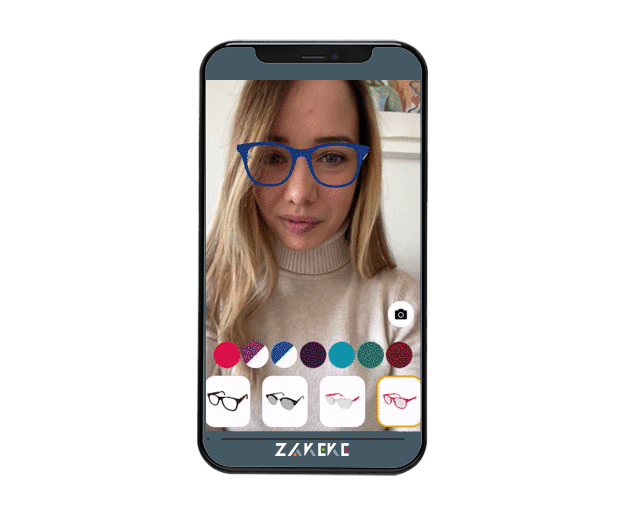
Source: Cristian Iconomu
Moreover, customers can determine which sizes are most suitable or assess the precise dimensions of a product within their living space. These capabilities, among others, effectively address the challenges associated with product selection in the realm of online shopping.
AR further facilitates customers in enhancing custom-fit products according to their preferences, heightening their interest and confidence in their buying decisions.
Improving Conversion Rates
Augmented reality, a technology that enables us to mentally place products into our physical surroundings without physical contact, introduces an element of gamification. It offers users an engaging and novel virtual experience that only enriches their online shopping journey but also heightens their interest and involvement.
For instance, consider the familiar scenario of trying on various pairs of shoes in a physical store, examining their fit and appearance in front of a mirror. This very solution of eCommerce mobile app development intrigues the customer to make a purchase.
Related Read:Voice Commerce: The Future of Shopping in eCommerce Apps
Reducing Return Rates
The intricate process of managing product returns often poses challenges for both customers and brands. To find a solution that benefits both parties as well as eCommerce mobile app development companies should consider embracing the advantages of augmented reality in your business operations.
The era of fast fashion is gradually giving way to a more sustainable trend known as slow fashion, particularly embraced by the discerning Gen Z consumers. This shift underscores the desire for well-considered purchasing decisions, as individuals are increasingly reluctant to clutter their closets with clothing they rarely wear.
Augmented reality emerges as a strategic tool and research reveals a remarkable 25% reduction in product returns, leading to a more efficient and profitable sales cycle. Undoubtedly, an impressive achievement, wouldn’t you agree?
How Can eCommerce Mobile App Based Brands Leverage Augmented Reality
Virtual Try-On Solutions
Virtual try-on solutions, powered by augmented reality (AR), are addressing a common online shopping challenge, and thus has become one of the hottest eCommerce trends. Shoppers often experience disappointment when the fit or color of a product doesn’t match their expectations, which can significantly impact conversion rates.
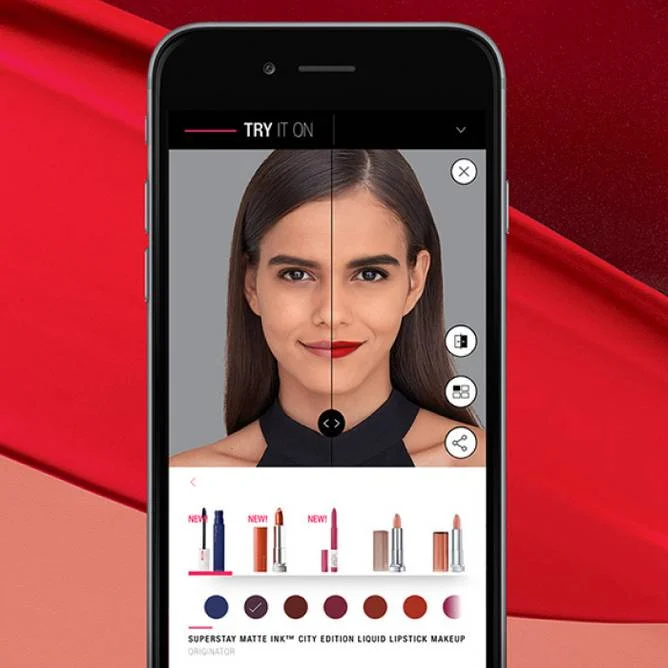
Source: Maybelline
To mitigate this, offering accurate information is essential. In the context of ecommerce mobile app development services, AR-driven virtual try-on solutions prove invaluable. These solutions are particularly popular in the beauty, fashion, and lifestyle sectors. Surveys indicate that over half of respondents consider AR the most effective way to try on various items such as makeup, hair colors, dresses, shoes, and accessories.
Esteemed brands like L’Oreal, Warby Parker, and Lenskart have already integrated virtual try-on features into their offerings, providing customers with a more informed shopping experience.
Preview Placement or Virtual Showroom
When consumers contemplate purchasing larger items like televisions, sofa sets, or refrigerators, a critical consideration is how these items will fit within their living spaces. This can pose a challenge even in physical retail stores.
Fortunately, the object preview placement feature addresses this concern by allowing customers to virtually position objects in their living rooms, bedrooms, or kitchens. This feature provides a real-time preview of how a product will appear in their desired environment.

Leading direct-to-consumer brands, such as IKEA, a renowned furniture manufacturer, have integrated AR technology through eCommerce mobile app development company into its customer experience. Shoppers can use the “IKEA Place” app to place furniture items in their homes, providing a realistic preview of how these pieces will fit into their living spaces.
Interactive User Guides
For products with a learning curve, introducing an interactive user manual through AR can be highly beneficial in aiding new customers’ understanding of product functionality.
This interactive user manual dynamically responds to user actions, delivering contextual support directly on the interface when individuals interact with software, websites, or applications.
In AR user manual apps, the process typically involves scanning the physical product and overlaying graphical arrows, animations, and explanatory text within the real-world environment, effectively guiding users through the product’s operation.

Source: Jack Daniel’s
Take Jack Daniels, for instance. They implemented a unique AR experience where customers could tour the distillery and understand the entire distillation process by scanning the bottle’s label with the Jack Daniels AR app. This not only brought fans closer to the brand’s history but also made their favorite drink all the more engaging and informative.
Social Media Filters
One of the most current and straightforward methods for brands to engage with customers and promote their products is through the utilization of augmented reality (AR).
Leading platforms such as Snapchat and Instagram have gained popularity in this regard, as they empower brands to craft interactive AR filters tailored to their products and services. Social media users can engage with these filters to virtually experience and interact with the offerings.
A prime illustration of successful augmented reality advertising emerged from the collaboration between Christian Dior and Snapchat. In their 2021 marketing campaign, this luxury brand leveraged Instagram and Snapchat filters to stimulate “virtual word of mouth.” The campaign achieved remarkable success, amassing over 1.3 million impressions.
ALSO READ : How Is Digital Transformation Redefining the eCommerce Industry?
Use Cases of Augmented Reality in eCommerce
Sephora Virtual Artist
Sephora utilizes 3D facial recognition for augmented reality in its marketing efforts. With the Virtual Artist app, users can scan their faces to experiment with different makeup products.
This feature boosts shopper confidence and their willingness to make a purchase by showing them how the makeup will appear after application.
Amorepacific Augmented Reality Mirror
In an Amorepacific store located in Seoul, an augmented reality mirror simplifies the process of determining whether a scarlet or pink lipstick shade complements a customer’s appearance, even when they are wearing a face mask.
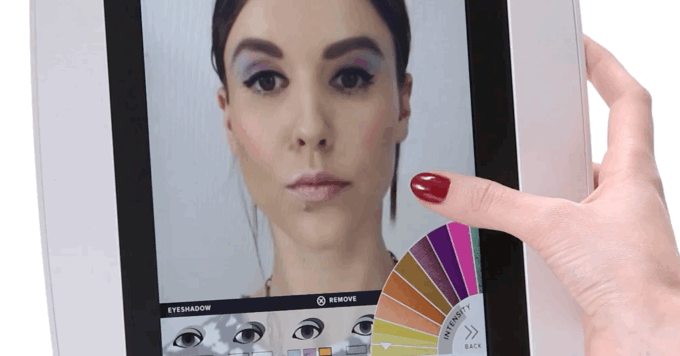
The mirror captures an image of the customer’s face and conducts an analysis, offering product recommendations based on skin texture while taking into account factors such as blemishes, wrinkles, or dark circles.
Subsequently, customers are presented with a computer-generated representation illustrating how various foundations, blushes, eye products, and lipsticks would appear on them.
Lego/Snapchat/Kabooki
In 2019, Lego and Snapchat joined forces to create an innovative London pop-up event that pushed the boundaries of augmented reality (AR). This collaboration coincided with the launch of a special edition Lego collection in partnership with the clothing brand Kabooki.
The pop-up space appeared empty except for a solitary plinth featuring a Snapcode (Snapchat’s unique take on QR codes). When visitors scanned the code, they were transported into a complete virtual Lego store experience, all within Snapchat’s Lens Studio.
This immersive experience included a Lego bouncer, a Lego DJ booth, Lego mannequins, and clothing racks. Most importantly, customers could make purchases directly within this AR-driven environment.
Wrapping Up
Augmented Reality is not just a technological marvel; it’s a game-changer in the world of eCommerce. By enhancing customer engagement, personalizing online shopping, improving conversion rates, and reducing product returns, AR has ushered in a new era of shopping convenience and satisfaction. As technology continues to advance, we can expect even more innovative applications of AR, further revolutionizing the way we shop online. So, whether you’re a business owner or a savvy shopper, embracing AR in eCommerce is a step toward a more immersive and enjoyable online retail experience.


